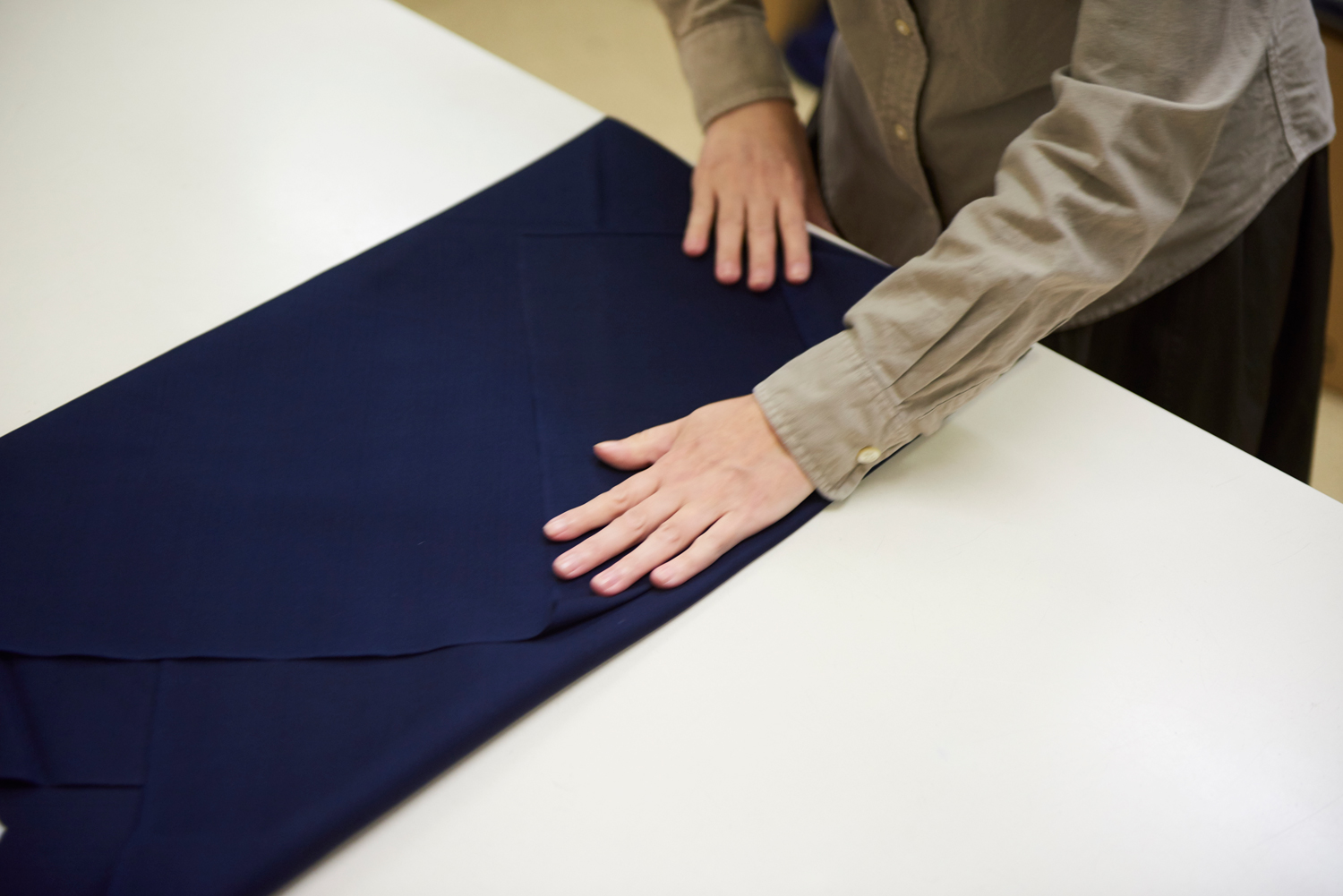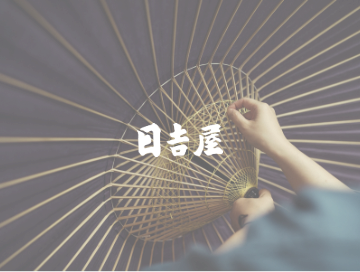A journey where a craftsman meets a craftsman







Maruwa Co., Ltd. / Hayashi Toshiharu Kyoto
A VERSATILE CLOTH FOR DAILY USE - THE FUROSHIKI TAKES ITS NAME FROM THE EDO PERIOD
The Mibu area was once the base of operations for the Shogunate police called
« Shinsengumi » at the end of the Edo period (1603-1867. The Mibugawa river flows through this area where many dyeing workshops used to stand side by side.
Taking advantage of the diverse dyeing techniques of this area, Maruwa Shogyo was founded in 1949 as a store specializing in furoshiki (wrapping cloth), noren (curtains),
and fukusa (handbags).
We spoke with the representative of Maruwa Shogyo, Mr. Toshiharu Hayashi, to learn about the origins of furoshiki and how it became part of the lives of ordinary people.
« According to some sources, the name 'furoshiki' became widely used during the Edo period. Prior to that, it was called ‘hirazutsumi (flat wrapping) or ‘koromo-zutsumi (kimono wrapping).
During the Edo period, public bathhouses became widespread and common people began to frequent them. During such visits, people used to spread a cloth on the floor to undress, change and wrap their clothes, hence the name "furoshiki," which means "something laid out in the bath"
Encouraged by the increased cotton cultivation throughout the country, the furoshiki culture spread during the Edo period. In the Meiji period (1868-1912), advances in production technology made mass production possible."Karakusa" a standard pattern for mass production was also invented during this period adding another new feature to the furoshiki culture.
« During the Meiji period, when everyone began to use surnames, a culture emerged in which each family would put its crest on furoshiki. This was one of the factors that contributed significantly to the wider use. »
Furoshiki can be used to wrap and carry anything from small to large items.
When not in use, it can be folded compactly and stored away. Because of all these advantages, furoshiki became a necessity in daily life, but also because it could bear messages or symbols according to the customer’s choice.
THE « KOTONOWA » BRAND REINTERPRETS THE CULTURE OF FUROSHIKI IN A MODERN WAY
When Maruwa Shogyo was founded, furoshiki came in a variety of styles. Each furoshiki store had its own area of expertise dealing in silk, cotton, or synthetic fabrics. Maruwa Shogyo mainly focused on cotton. However, in the 1970s, the context for the use of furoshiki changed drastically.
« The changes in the Japanese lifestyle were significant. After a peak in 1970, the production of furoshiki declined as the number of daily situations where furoshiki was used decreased rapidly. Although furoshiki was still in demand as a souvenir, gift, or novelty, there was still a gap between the actual needs and use. The furoshiki became a redundant piece of cloth in the wardrobe. »
With the demand for furoshiki declining, Mr. Hayashi, the company representative since 2006, began working with overseas designers to create products in an effort to cope with the situation. At a time when the popularity of Scandinavian design was on the rise, he hired two Finnish designers and launched the « KOTONOWA » brand.


The "KOTONOWA" brand was established in 2011.
The Japanese word "Koto" in KOTONOWA refers to things and the ancient capital city of Kyoto, with the image of them forming a harmonious circle. When the brand was launched, the company's philosophy was also defined: "connect, protect, convey.
With furoshiki, Maruwa Shogyo wants to preserve and convey the cultural and emotional values inherent to the cloth.
TSUNAGU - A JAPANESE BRAND DEVELOPED IN COLLABORATION WITH FRENCH DESIGNERS
In 2016, Maruwa Shogyo developed a modern multi-purpose cloth that can be used as a shawl or tablecloth, with a stylish Scandinavian design. In order to further develop KOTONOWA's craftsmanship, the company participated in the "Kyoto Contemporary" project which I produced. This project was sponsored by the city of Kyoto to support the development of overseas sales channels for bearers of the traditional crafts.
« Although the use of furoshiki has decreased in daily life, Japanese people are still familiar with it. However, I thought it was necessary to come up with a pertinent idea to appeal to foreigners who had never heard of the cloth. As the theme of the "Kyoto Contemporary" project was a collaboration with overseas designers, I decided to apply. »
Maruwa Shogyo decided to team up with Anki Designers, a trio of French designers, for the "Kyoto Contemporary" project. After Mr. Hayashi explained about the history and use of furoshiki, Anki Designers understood that this was an eco-friendly bag that had been used in Japan for a long time. Their first rough sketches, inspired by that day's lecture, became the basis for the product development.
The finished product is a bag created by tying the ends of a furoshiki to a leather handle. The key point of this product is that even people who do not know how to tie a furoshiki, can simply pass the ends of the cloth through the leather handle and securely connect it. Maruwa Shogyo named this handle "TSUNAGU" and obtained a design registration.

« The inspiration and design skills of the designer trio to reinterpret the furoshiki were truly remarkable. In the past, there has been a variety of furoshiki products that have been modified by adding Velcro tape, holes, zippers, and other ideas. Initially these items gained attention but eventually they disappeared from the market. In this sense, I thought that a simple square piece of cloth was the most convenient form for furoshiki, and as a furoshiki maker, I wanted to keep it that way. »
« CONNECT, PROTECT AND CONVEY »- FUROSHIKI DRAWS CROWDS AT THE PARIS EXHIBITION
Also in collaboration with the Anki Designers, Maruwa Shogyo produced sophisticated graphic designs for the furoshiki. Together with other workshops that had participated in the "Kyoto Contemporary" project, the company was able to exhibit at the "Maison & Objet" international exhibition in Paris. Mr. Hayashi recalls his surprise and excitement.
« At first, I was half worried about how well our products would be received but I was really surprised. It is rare for furoshiki to attract a crowd at a Japanese exhibition, but in Paris, one buyer after another came, and we were able to conduct business negotiations. »
Afterwards, Maruwa Shogyo received inquiries from a well-known brand and the KOTONOWA brand took a big step toward overseas expansion. The experience of not only making furoshiki but also planning and developing handles to match the furoshiki, procuring materials, and designing the furoshiki, was a great achievement for the company.
The KOTONOWA brand translates the potential of furoshiki to "connect, protect, convey" into a form that can be used around the world. The furoshiki culture that flourished in the Edo period has been infused with new life through overseas design, and may well form a new tradition in the future.

